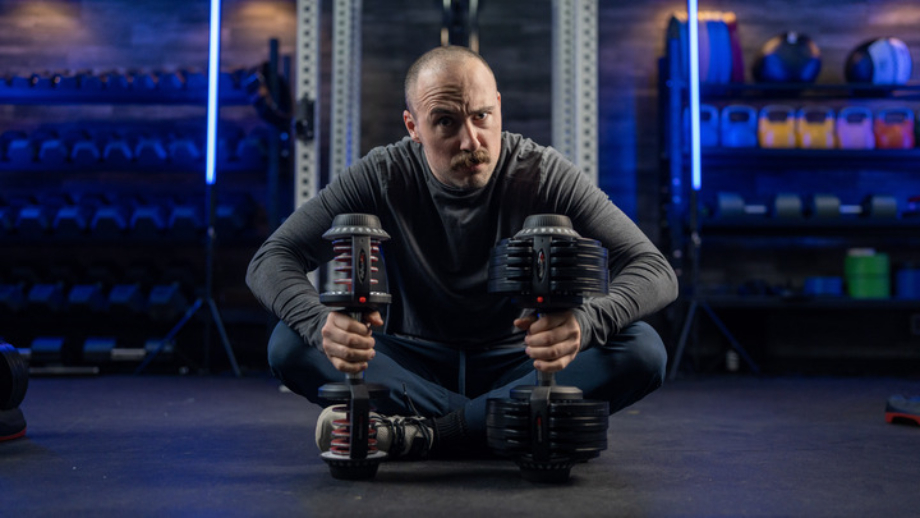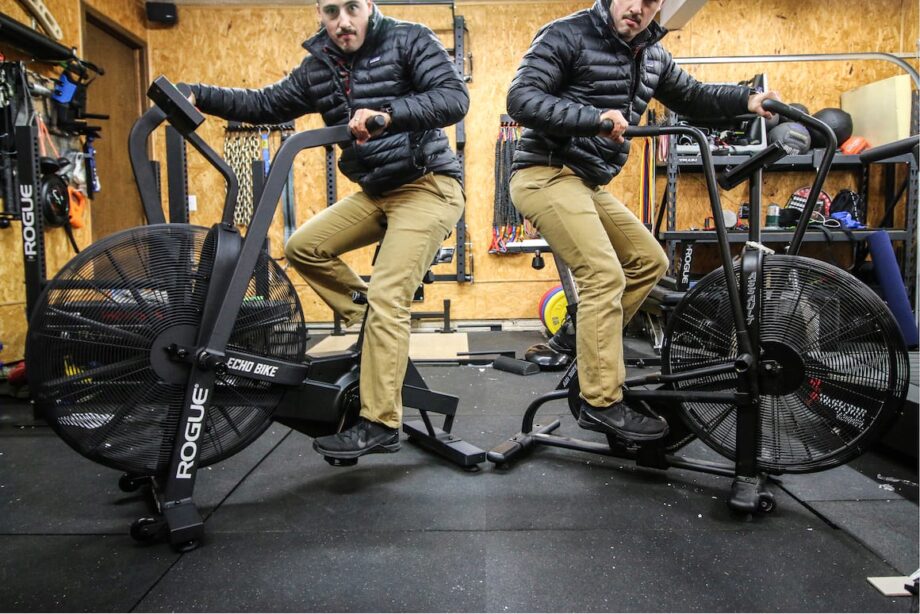If you’re reading this, I assume you’re probably pretty familiar with the brand Kabuki Strength. In the past few years, they’ve put out some of my favorite products including the versatile Trap Bar, Transformer Bar V4, and New Generation Power Bar.
Kabuki recently released a flywheel, and I’ve been itching to try it. In this Kabuki Kratos Flywheel review, I’ll walk you through what’s included, unique aspects of this product, and my final thoughts. As always, I’ll give you all the details you need to make a smart buying decision for you. For those of you who aren’t familiar with flywheel training, it can be an effective way to build strength within your body’s connective tissue. It can also increase overall power, muscle hypertrophy, and force.
Essentially, it’s useful for eccentric overload training where the muscle is stretched during both the lifting and lowering of your reps. The resistance is inertia driven, which means it is all based on how much force the user puts into the movement with the flywheel.
Kabuki Kratos Flywheel
Kabuki Kratos Flywheel

Product Highlights
The Kratos is different than anything we’ve done before. At first glance it might look complex, but at its core the Kratos generates its training effect through one of the most basic laws that govern the physical universe.
Pros & Cons
Bottom Line
A Quick Look at the Kabuki Kratos Flywheel
My Favorite Things:
- Allows for a combo of both horizontal and vertical pulling in one machine
- Virtually unlimited resistance
- Lots of versatility without a massive footprint
My Callouts:
- Some parts are 3D printed and are more prone to breakage
- Large unit and not easily moveable
- Pricey shipping
Video Review

Is the Kabuki Kratos Flywheel Worth It?

Great for:
- Athletes looking to improve specific movements (ex. golfers, swimmers)
- People looking to rehab or prevent injuries
Not recommended for:
- People with a really small home gym (unless this is a primary piece)
- Individuals on a tight budget
- People who enjoy the somewhat higher quality Exxentric kBox and kPulley and are willing to purchase both separately
What Comes with the Kratos Flywheel?
The Kabuki Kratos will run you just under $2,600. If you don’t want to spend that amount of money in one go, there is an option to finance through Klarna. You’ll only have to pay $108.33 per month for 24 months with 0% APR.
With the Kratos, you get to choose if you want a wall or rack mount for your flywheel. You also get to pick between a Front Squat Harness or Belt Squat in your preferred size from Spud. The free Angles 90 Grips usually cost about $90, so to get them free with purchase is awesome. I think these extras are something that Kabuki could’ve easily skimped on but chose not to and instead added further value by including high-quality accessories.
Also included in your purchase are two different sized flywheels (medium and extra large) with the option to buy more separately. You’ll also get six months of free access to Kabuki Education’s Video Library, which has exercise videos for the Kratos.
Shipping and Assembly
As with most Kabuki products, shipping comes separately and can run a pretty penny. Once you’ve added the Kratos to your cart, you’ll be able to calculate your shipping cost based on zip code. The cheapest shipping option was just over $250 when I plugged in my zip code.
For most people, the assembly is pretty simple. Once you’ve made your purchase, Kabuki sends you video and print instructions to the email address that you provide at checkout. If you pick the wall mount, your shipment will arrive in 2 boxes. If you go with the rack mount, you’ll get everything in one box. Any accessory you choose will be shipped separately.
Luckily, I didn’t find the assembly instructions to be too difficult. Kabuki did send me an early release beta version to test, so my machine may look slightly different than yours if you order it today.
However, I was disappointed to note some minor damage from shipping. Although the pieces damaged weren’t major (back stopper and the hook that holds the handles), it’s still never fun to see a damaged product when you open the box. Parts of the Kratos are manufactured with a 3D printer, which sounds cool in theory but objectively seems to make for overall weaker pieces versus an alternative option like cast aluminum or injection molded parts. That said, if something like this does happen, Kabuki will replace the part free of charge.
Compatibility with Different Racks
If you decide to mount your flywheel via your squat rack, you’ll first need to make sure that it is compatible with the criteria. Here’s what your rack needs to have:
- Standard 3″ square tube rack
- Unobstructed base
- Standard 2″ hole spacing
- Standard 5/8″ hole diameter
Although the criteria will include the majority of racks, it knocks out theRogue RM-3 because of the 1” hardware. I did notice in the comments on the website that Kabuki plans to release a rack mount that will fit hardware of that size in the coming months.
Belt Squat Sizing
Here are the sizing options for the belt squat straight from the horse’s mouth (aka the Kabuki website):
- Small (45″ long, 3.5″ wide)
- Medium (45″ long, 5.5″ wide)
- Regular (54″ long, 5.5″ wide)
Front Squat Harness Sizing
Trying to decide what size harness to get? Here’s the difference between the sizes:
- Small (80-150lbs)
- Large (150-225lbs)
- XL (225-325lbs)
- XXL (350lbs +)

How Big is the Kabuki Kratos Flywheel?
The base of the Kratos measures 48″ x 34”, so the flywheel is a space commitment. It is also a good idea to keep in mind that you have to bolt the system to the wall or to your rack, so it’s not easily moveable. You’ll also need to account for extra space in order to actually fully utilize the pulley system.
All that to say, the birch base wrapped in a metal shroud is well made and reminiscent of a weightlifting or powerlifting platform. I feel that it is solid and will last for many years to come.

Using the Kabuki Kratos Flywheel
I really enjoyed training with the Kratos flywheel system. As a refresher, there are no attached weight plates on a flywheel as the resistance is based on inertia from the flywheel. The harder you pull or the faster the wheel spins, the more you have to resist it.
Besides the obvious squats and pulls you might think to do on a flywheel, I also enjoyed doing deadlifts, squats, curls, and side delt raises. Different isometric holds are also easy to do on the Kratos.
You can change out the flywheel easily depending on what exercises you plan to do. I’d recommend using the XL flywheel for lower body movements because it can present more inertia.
I was happy to note how uncomplicated it was to change the Kratos from horizontal to vertical pulling. It took very little effort and time. You simply flip a button on the pulley system to disengage it and change its placement.
If you want to do vertical pulls, there are two different spots on the platform to clip the pulleys in. The option to do horizontal pulls in the same unit really appeals to me. I think it’s an especially useful option for people who train for a specific sport, like swimming or golf. Since the load isn’t static like in cable machines, the work will be equally as difficult in the acceleration portion as it is in the deceleration phase. This makes for overall more effective training.
I’ve previously tested both the Exxentric kBox andkPulley and think they’re each very solid for what they are. I love both pieces of equipment, but you do have to keep in mind that they are sold separately. The Kratos essentially combines both Exxentric flywheels into one, which can make this a good option for some due to the price. I love having the option to do both horizontal and vertical pulls on the same piece of equipment.
This isn’t to say I think a flywheel should totally replace traditional strength training, Olympic lifts, or barbell complexes. I would instead add the Kratos in as another avenue to gain strength and power. Unfortunately, I know the price tag can be a deterrent if this isn’t going to be your only piece of home gym equipment.

Kabuki Kratos Flywheel Specs
Vertical Mount | Choose between rack or wall mount |
Belt Accessories | Choose between Belt Squat Belt and Front Squat Harness |
Flywheels | Included medium and XL (can purchase additional sizes separately) |
Price | $2,599.99 |
Movement | Both horizontal and vertical |
Platform Dimensions | 48″ x 34″ |

Customer Experience
The customer service on the Kabuki website is pretty solid. Even though there isn’t a live chat option, you can still reach the brand through email atinfo@kabukistrength.com or at 503-974-0222. There is also a support button in the lower right hand corner of the website where you can submit a query alongside pictures.
Warranty
The Kratos has a 12-month limited warranty not including wear items like straps, pulleys, and bearings. This is pretty standard as other flywheels such as the Exxentric KBox 4 have a 12 month warranty as well.
Return Policy/Money Back Guarantee
Kabuki has a 14-day return policy but you have to request the return either through the ‘Support’ button on the website or via email. You are responsible for the return shipping unless there was a manufacturing defect. This is definitely something to keep in mind because shipping a heavy item back like the Kratos will cost you a few hundred dollars.
You will only get a full 100% refund if you choose to take the money in the form of Kabuki store credit. Otherwise, you’ll be refunded the purchase price minus a 15% processing fee.
Final Verdict of our Kabuki Kratos Flywheel Review
All in all, I think the Kratos Flywheel is a solid option because of its ability to work both horizontally and vertically all in the same unit. It’s cheaper and more palatable than buying the kBox and kPulley separately. If the price of the unit is the least of your concern, then I would recommend the Exxentric Flywheel Systems first as they are truly the most well-made in the industry.
However, the Kratos from Kabuki is a better value at both a lower price point and the ability to have multiple pulling angles in one unit. I would still recommend this as I think it’s a great option and will introduce more people to flywheel training since Kabuki is so well-known.
Kabuki Kratos Flywheel FAQs
Where is the Kabuki Kratos Flywheel manufactured?
The Kratos Flywheel is made in the USA in the beautiful Portland, Oregon. *Bald eagle screeches in the distance*
What is the difference between the Kratos Flywheel and other flywheels?
The Kratos Flywheel combines both vertical and horizontal pulling into one unit. The dual-axis design is patent pending and unique to the Kratos.
What other accessories can I buy that are compatible with the Kratos Flywheel?
There are a multitude of options you can purchase separately on the Kabuki website that will work with the Kratos Flywheel.
Here’s the list:
Straight bar handle, Bodybuilder towel strap, Adjustable loading strap, Dynamic stick, Hamstinger deluxe strap, Zercher straps, Ankle cuffs, Charger harness, and Cold war puller
Who created the Kabuki Kratos Flywheel?
Chris Duffin is the mastermind behind Kabuki Strength and helps come up with innovative products to change the fitness game.
What are the benefits of flywheel training?
Flywheel training is beneficial in that it is a different way to train compared to static functional trainers. Here are a few things that can improve with regular flywheel training:
Full Rating
Kabuki Kratos Flywheel

Kabuki recently released a flywheel, and I’ve been itching to try it.In this Kabuki Kratos Flywheel review, I’ll walk you through what’s included, unique aspects of this product, and my final thoughts. As always, I’ll give you all the details you need to make a smart buying decision for you.For those of you who aren’t familiar with flywheel training, it can be an effective way to build strength within your body’s connective tissue. It can also increase overall power, muscle hypertrophy, and force.Essentially, it’s useful for eccentric overload training where the muscle is stretched during both the lifting and lowering of your reps. The resistance is inertia driven, which means it is all based on how much force the user puts into the movement with the flywheel.
Product Brand: Kabuki Strength
Product Currency: USD
Product Price: 2599.99
Product In-Stock: InStock
4.2







